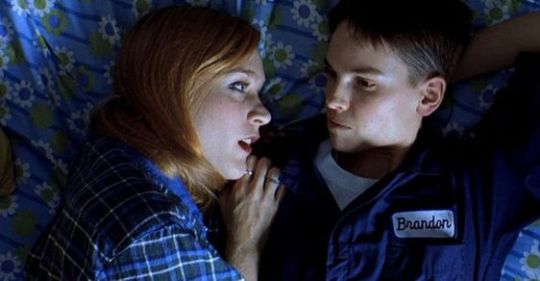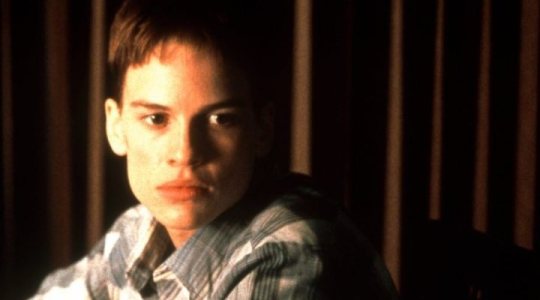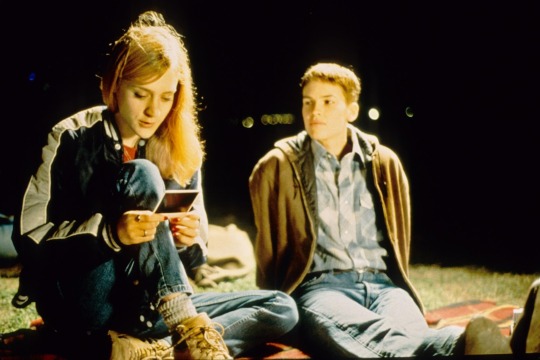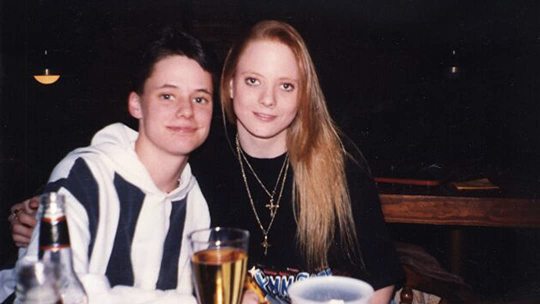#LanaTisdel
Text
Cine: Los muchachos no lloran (1999)







Aunque hace no mucho tiempo, la actriz Hilary Swank revelara que se arrepentía de haber interpretado este rol, pues le parecía más pertinente que hubiese estado a cargo de un hombre transexual, es imposible no suponer que, de ese modo, hubiese revestido igual trascendencia. Tal es su compromiso a la hora de transformarse en Brandon Teena (1972-1993) que no podemos imaginar mejor elección: al fin y al cabo, su fenomenal trabajo le ha dado un Oscar y un Globo de Oro a la Mejor Actriz Principal, entre otros lauros destacados.
La película parece establecer dos partes muy bien divididas: en la primera hora se narra el encuentro de Brandon (un muchacho cuyo verdadero nombre es Teena Brandon, vive con su primo Lonny -Matt McGrath- en Lincoln, Nebraska, y tiene que lidiar con un problema legal) y Lana Tisdel (Chloë Sevigny, nominada al Oscar y al Globo de Oro como Mejor Actriz Secundaria), una adolescente que vive en un entorno complicado por el alcohol, las drogas, la delincuencia y hasta un ex novio (John Lotter, interpretado por Alexander Sarsgaard) que es invitado habitual de su casa. Todo se inicia cuando Brandon se ve involucrado en un incidente en un bar de Falls City en el que conoce a Lana, John, Marvin 'Tom' Nissen (Brendan Sexton III) y Candace (Lecy Goranson). Allí se desarrolla una relación de camaradería que parece transformarse en idílica y que cuenta con el apoyo de la madre de Lana, Linda (Jeannetta Arnette).
Pero la historia comienza a complicarse en una segunda mitad de creciente tensión por el descubrimiento de la identidad biológica, que culmina con la demencial tragedia que salpica los últimos días en la vida de un chico que sólo quería ser feliz y escapar con su chica de un mundo descarnado y prejuicioso.
Un trabajo extraordinario de la guionista (junto con Andy Bienen) y directora Kimberly Peirce que se ha ganado con justicia un lugar en la historia del cine, si no LGBTQ, estadounidense: en 2019, el filme llegó al National Film Registry de la Biblioteca del Congreso por ser “cultural, histórica y estéticamente significativa”.
(Nota al márgen: en efecto, un visionado de la película contradeciría la intención de este blog de ofrecer material sobre la mirada del cine LGBTQ a los niños y adolescentes, puesto que Brandon no lo es porque aquí cumple 21 años, pero decidí incluir esta película porque no está muy lejos de esa franja etaria y, además, es esencial en la historia del cine contemporáneo y en la de la lucha por los derechos civiles y sociales de las personas LGBTQ).
Aquí, los verdaderos Brandon Teena y Lana Tisdel:

Y aquí, un trailer:
youtube
#cine#LosMuchachosNoLloran#BoysDontCry#1999#adolescencia#transexualidad#BrandonTeena#Oscar#MejorActriz#HilarySwank#Lincoln#Nebraska#MattMcGrath#Lonny#GlobodeOro#LanaTisdel#ChloëSevigny#JohnLotter#AlexanderSarsgaard#FallsCity#TomNissen#BrendanSextonIII#Candace#LecyGoranson#JeannettaArnette#Linda#AndyBienen#KimberlyPeirce#NationalFilmRegistry#BasadaEnUnaHistoriaReal
6 notes
·
View notes
Text
Everybody Cried
The movie Boys Don’t Cry is a film released in 1999 by director Kimberly Perice following Brandon Teena, a transgender male-to-female facing a “sexual identity crisis”. It follows him on his journey from his hometown, after his ex-girlfriend finds out his true biological sex, through to Falls City, Nebraska where he begins his new love affair with a girl named Lana Tisdel. However, he gets into more trouble than he could’ve ever imagined when his lies, his crimes, and, for the second time, his true sex all come out.
This film is based on the tragic true story of a transgender male by the same name as was commended for its being real and emotional without being edgy or betting on stereotypes. Brandon’s character is not particularly stereotypical and is complex. His character made this movie into a “breakout text” as it was one of the first films to represent male-to-female transgendered people in a real and believable way.

Image source:https://www.rogerebert.com/reviews/boys-dont-cry-1999
There is a huge part of the film that focuses on sexual violence and hate crimes against transgender people. As discussed in class, transgendered people, especially of color, face so much criminal and sexual violence. Transgender people are faced with “violence such as harassment, stalking, vandalism, and physical and sexual assault”(Office for Victims of Crime). The movie’s portrayal of rape and assault, followed by manipulation and, in the end, murder is exactly the fear amongst the transgender and queer communities. Brandon is raped and murdered by John Lotter, an ex-convict and Lana’s friend, who murder’s Brandon because he is a “dyke” and reported the rape. While the scene’s are raw and sometimes uncomfortable, it is a reality that plagues the trans community with fear. However, like every movie, it is not perfect and Boys Don’t Cry in particular has strong critics that believe the representation in the film has its downfalls.
Hilary Swank who plays Brandon Teena is a cis female playing a transgender man and many critics disagree with the casting choice. Regardless of her performance in the role, many people believe that Brandon should have been played by a transgender man and fight back against the choice to cast Swank. Because Hilary is not a trans man, she naturally casts heteronormativity on Brandon’s role, preventing a real transgender man from representing the character. There was even a protest regarding Swank’s role in the movie (Dry, Jude). Though this is not Hilary’s fault, many still argue her casting was not the right choice. This roots back to the discourse of “best actor” as discussed in class from Dr. Martin’s piece The Queer Business of Casting Gay Characters on U.S. Television, where directors justify not hiring minorities for roles they represent in favor of a better actor who is almost always does not identify with the minority role they are playing. However, I don’t think this is a case of best actor. 1999, when the movie was released, was a different time than today and Hilary Swank was taking a risk taking the role at all. Her performance in the role does not glorify what trans people go through nor does her playing the role invite any discrimination to others who may have tried for Brandon’s role.

Image source: http://www.dvdexotica.com/2015/06/the-european-cut-of-boys-dont-cry-is.html
I have also noted that Boys Don’t Cry focuses on a completely white cast. This could be potentially problematic as white becomes the only representation in the movie. There are no people of color throughout the movie or, at least, no people of color as main characters. Some argue that this is because the movie takes place in Nebraska and that the state does not have a large racial diversity to begin with. Others argue that including other races in the story where they were not present would be creating false representation and muddy the biographical qualities of the story instead. Counter-arguments state that the movie could’ve at least included some racial diversity amongst the background characters as it wouldn’t have taken away from the biographical integrity of changing the main characters races for the sake of equal representation. I do agree with the argument that there could have been some more racial diversity in the Nebraskan setting but I think casting a black character for the main roles could have proven dangerous for more social discourse. None of the characters in the film are particularly “good” people, maybe with the exception of Lana in the end. If a black actor had been cast as John or Tom Nissen, his friend and a colluder in Brandon’s murder, it could because a misunderstanding as to representing people or color as being associated with crime or as murderers. If a person of color was cast as Lana’s mother or her friends it could be misinterpreted as a social commentary on people of color being drunks or druggies. There are many ways casting could miscontrew the message but I don’t believe it is right to turn a movie focusing on trans issues into a movie half-tackling and half-creating race issues in addition to tackling trans issues.

Image source: http://ravepad.com/page/boys-dont-cry/images/view/1302188/Download-wallpaper-Boys-Do-not-Cry-Boys-Don-t-Cry-film-movies-fr
Overall, I agree that the movie has its flaws as all films do. Some of the criticism lies in the right place and some, I believe, is left to unreasonable expectations or overanalyzations. People and critics of today need to understand that the film comes from a different time, almost two decades from today and, at the time, this film was nothing short of taboo. From its open and believable representation of trans people and the violence and prejudice they still face today, Boys Don’t Cry is a breakout film for a reason. It’s telling of Brandon Teena’s story did something many films were afraid to do: starting a conversation about transgender people as people and not objects or the mentally deranged. This is why I believe Boys Don’t Cry is a great breakout text for it’s time, critics and all, and should be used to further the representation of the transgender community of today through the representation the community had in the past.
References:
Dry, J. (2016, December 14). 'Boys Don't Cry' Protests: Why We Should Listen to Trans Activists Criticizing The Milestone Film - Editorial. Retrieved from https://www.indiewire.com/2016/12/kimberly-peirce-boys-dont-cry-reed-transgender-1201757549/
Martin, A. L. (2018). The Queer Business of Casting Gay Characters on U.S. Television. Communication, Culture and Critique, 11(2), 282-297. doi:10.1093/ccc/tcy005
Peirce, K. (Director). (1999). Boys Don't Cry [Video file]. United States: Fox Searchlight Pictures.
Office for Victims of Crime (OVC). (n.d.). Retrieved from https://www.ovc.gov/pubs/forge/sexual_numbers.html
19 notes
·
View notes